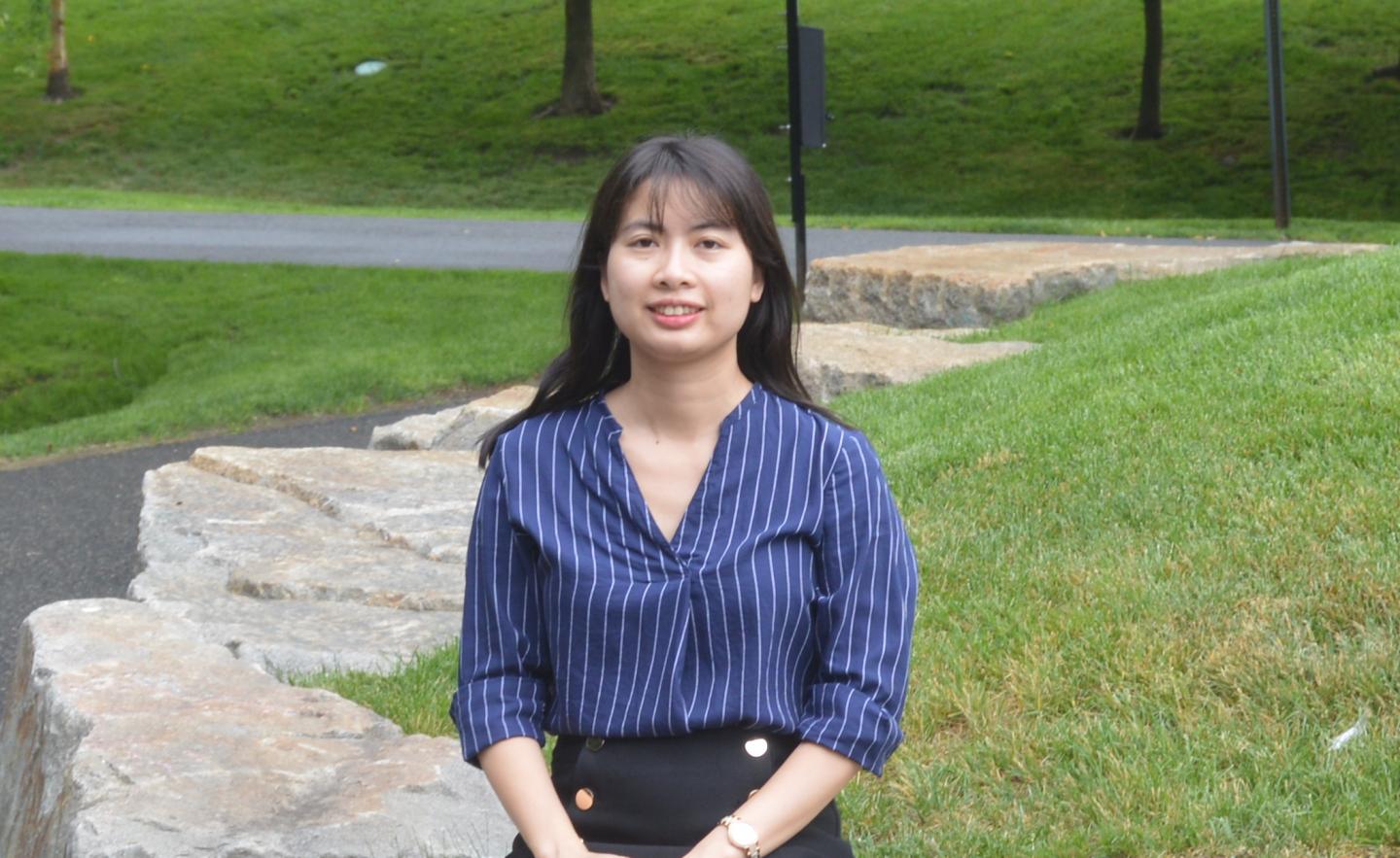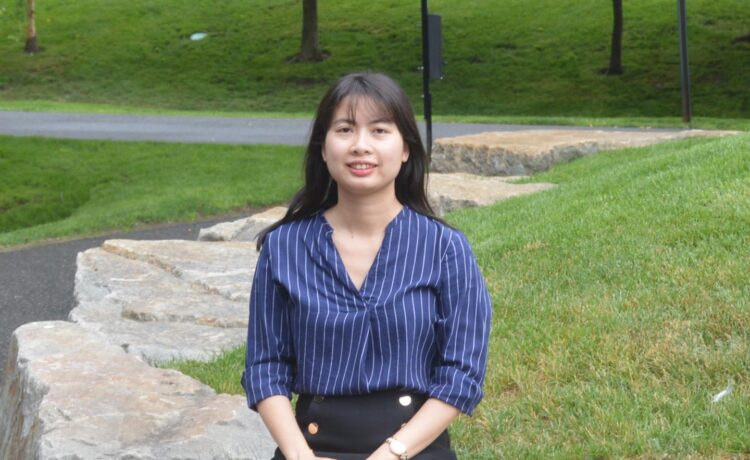As the Nathan Isgur Postdoctoral Fellow in Nuclear Experiment, Dien Nguyen will probe atomic nuclei to learn more about how the particles inside interact

Credit: Dien Nguyen
NEWPORT NEWS, VA – Dien Nguyen (Zee-en Wen) studies some of the smallest units of matter on Earth to learn more about massive objects in space. Now, she’ll be conducting her research as the Nathan Isgur Postdoctoral Fellow in Nuclear Experiment at the Department of Energy’s Thomas Jefferson National Accelerator Facility.
“I feel happy and excited. It’s an honor for me to receive this fellowship,” Nguyen said. “I also deeply appreciate the support of a lot of people who I’ve worked with.”
Jefferson Lab and the Southeastern Universities Research Association established the Nathan Isgur Postdoctoral Fellowship in 2003 as a memorial to the late Nathan Isgur, who served as head of Jefferson Lab’s Theory Group and as chief scientist until his death in 2001. While either experimentalists or theorists could be awarded a fellowship, the program was doubled in 2019 to include two different fellowships: a Nathan Isgur Postdoctoral Fellowship in Nuclear Theory and a Nathan Isgur Postdoctoral Fellowship in Nuclear Experiment. Each three-year-long fellowship furthers the early career of a person displaying extraordinary scientific ability, by allowing the recipient to pursue independent research at Jefferson Lab. Nguyen is the first female Nathan Isgur Postdoctoral Fellow in the history of the program.
In her fellowship, Nguyen will study how protons and neutrons interact. These two particles, collectively known as nucleons, form the atomic nuclei that make up most of the matter on Earth.
Specifically, Nguyen examines how nucleons interact at very short distances.
“The nucleons are moving inside the nuclei, and when they get really close together, their interaction becomes more and more complicated to study,” Nguyen said.
She’ll conduct experiments to look at this complicated interaction by shooting electron beams at targets of different atomic nuclei. These beams are generated inside Jefferson Lab’s Continuous Electron Beam Accelerator Facility, a DOE Office of Science User Facility for the study of nuclear physics. In the experiments, the electrons knock nucleons out of the nuclei and into a detector.
“What we capture in the detector is a picture of what happened inside nuclei. From that picture, we can understand how the nucleons interact with each other to form almost everything in our world,” she said.
Nguyen finished her doctorate in nuclear physics in December 2018 from the University of Virginia, where she was also a 2017-2018 JSA Graduate Fellowship recipient. She is also a postdoctoral researcher at the Massachusetts Institute of Technology. She’s working remotely, and when she eventually moves to Newport News to work on-site at Jefferson Lab, she’ll maintain her affiliation with MIT and travel back and forth to continue collaborating with her team there.
Nguyen will investigate nucleon interactions at short distances in both heavy and light nuclei during her fellowship. She explained that the more nucleons in an atomic nucleus, the heavier and more complicated to study it is. One heavy nucleus she’ll examine is calcium-48, a form of calcium that’s considered neutron-rich, because it has more neutrons than protons (28 neutrons and 20 protons, to be specific). In addition to providing insights into nucleon interactions on Earth, her experiment will also affect physicists’ understanding of neutron stars.
A neutron star is the collapsed core left behind by a star 10 to 20 times larger than our sun. They are observable, but mysterious. Regarded as a different state of matter, neutron stars consist mainly of neutrons–akin to giant neutron-rich nuclei–making calcium-48 nuclei a miniature proxy for neutron stars.
“Studying a very tiny object on Earth helps us make inference on a giant object in space.” she said. “That makes me think my research is very interesting.”
Nguyen’s research on neutron-rich nuclei will also expand upon previous findings. During research for her thesis, she helped confirm how protons and neutrons move inside nuclei. Recent studies Nguyen is involved in showed that the nucleons present in fewer numbers are moving faster than the nucleons present in larger numbers.
That means that in neutron-rich nuclei, the protons are moving faster than the neutrons. This finding may influence nucleon interaction models and physicists’ understanding of neutron stars.
“Neutron-rich systems are not simple, and we still have a lot to learn,” she said. During her fellowship, she’ll continue experiments on these systems.
However, to fully understand heavy nuclei, including neutron-rich systems, Nguyen has to study lighter nuclei, as well. While lighter nuclei, like helium, are still complicated, they’re simple enough for theoretical physicists to perform exact calculations describing their nucleon interaction. Heavy nuclei are too complicated for exact calculations.
“A lot of calculations have been done, but we don’t know how good the calculations are,” Nguyen explained.
Comparing experiment results with calculations allows physicists to quantitatively benchmark how good their current understanding of nucleon interactions is. Light nuclei calculations are especially important because they’re the first step for every calculation about heavy nuclei.
Studying light nuclei during her postdoc gave Nguyen new ideas, which she’ll pursue during her fellowship. In one of her experiments on light nuclei at Jefferson Lab, she’ll broaden her research to investigate the spin structure of nucleons.
“This fellowship gives me a unique opportunity to build up a research program on both heavy and light nuclei.” she said. “It will be a huge amount of work, but I hope that three years is enough time for me to complete all these tasks.”
Though Nguyen admits she’s nervous to be one of the youngest researchers awarded this fellowship, she believes in herself.
“They choose me because they trust me, so I should trust myself.”
Nathan Isgur Fellowships are jointly funded by the Jefferson Science Associates Initiatives Fund and Jefferson Lab. The JSA Initiatives Fund supports activities that further the scientific outreach; promote the science, education and technology of Jefferson Lab; and benefit the lab’s extended user community in ways that complement the lab’s basic and applied research missions.
Further Reading:
Physicists Study Mirror Nuclei for Precision Theory Test
Jefferson Lab Establishes New Fellowships in Nuclear Physics and Accelerator Science
Media Contact
Kandice Carter
[email protected]
Original Source
https:/





